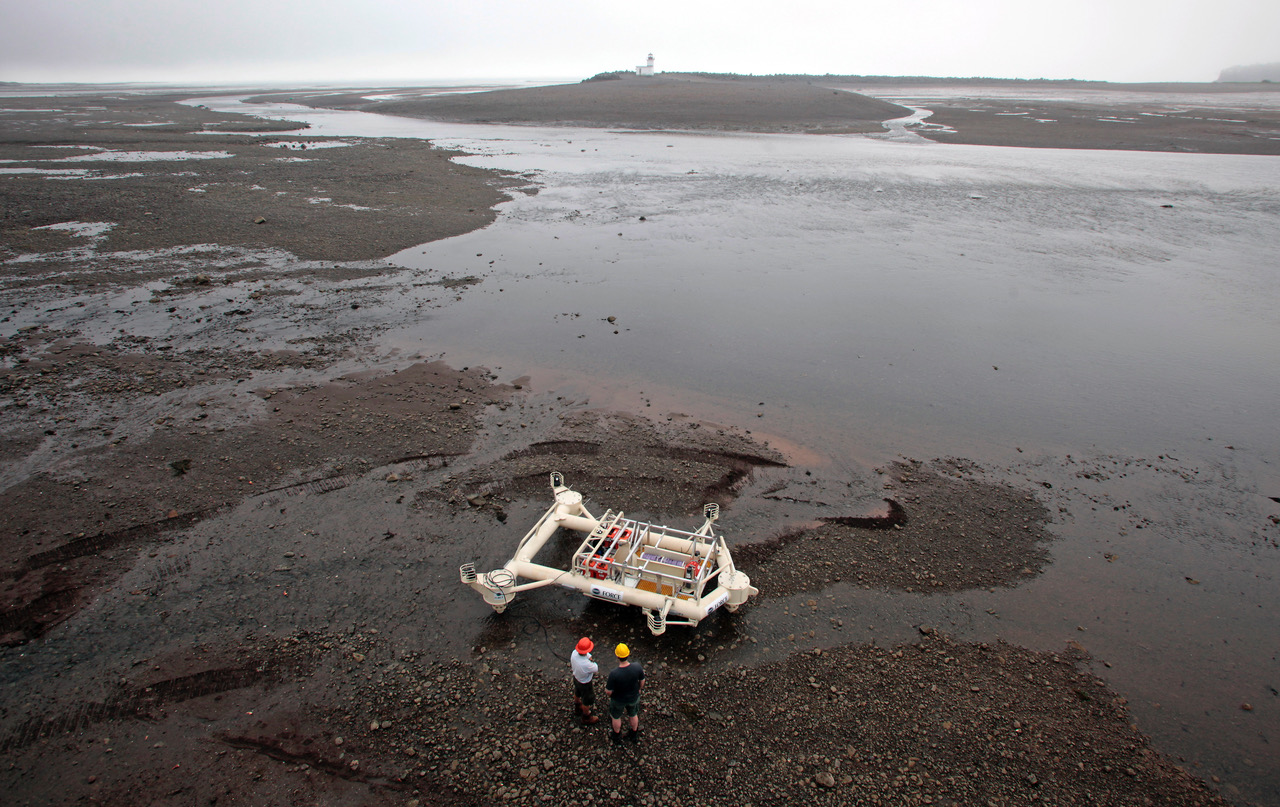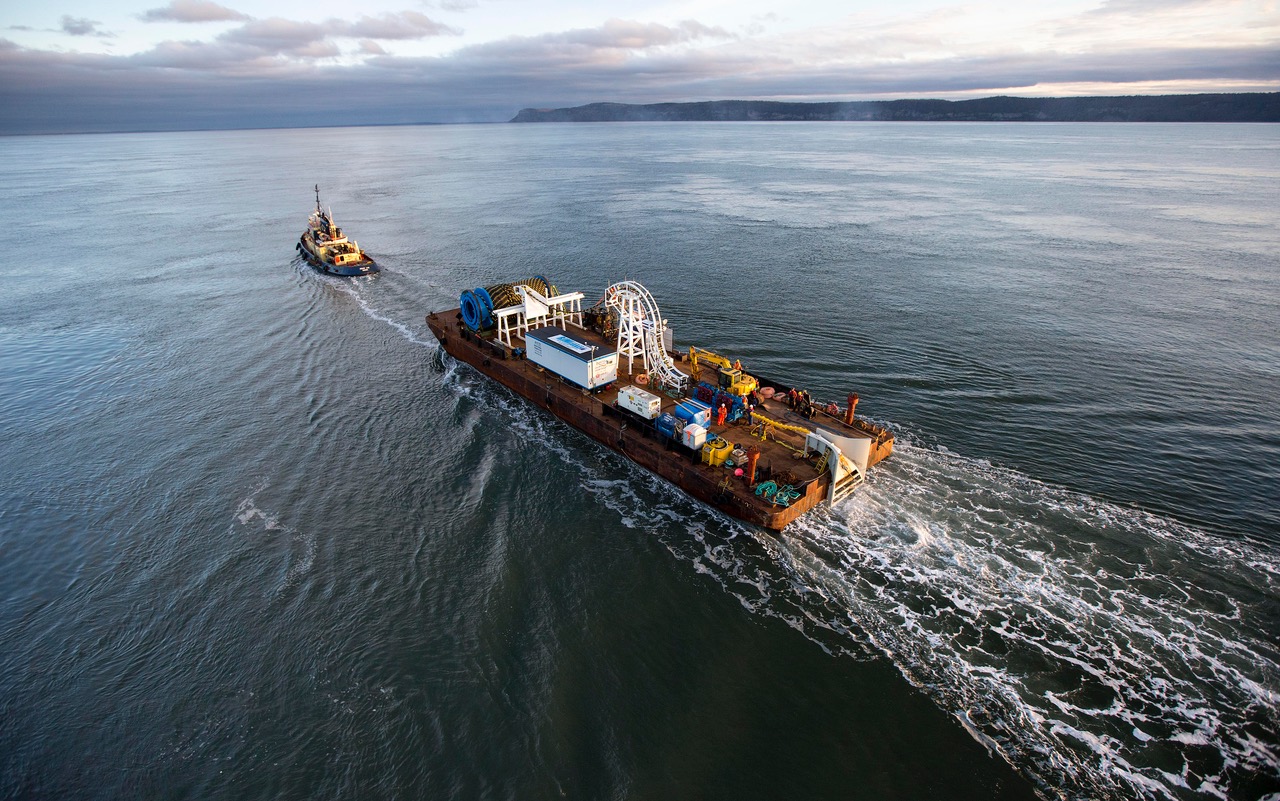Tidal Energy Project in the Bay of Fundy
Lead Proponent: Fundy Ocean Research Center for Energy (FORCE)
CEF Contribution: $ 23 M
Project Total: $ 50.7 M
Location: Minas Passage, Bay of Fundy, Nova Scotia
Project Background
The Bay of Fundy has the highest tides in the world and efforts to harness energy from the tides date back 100 years. It is estimated that more than 2,500MW may be extracted from the 8,000MW of kinetic resource of the Bay of Fundy. Fundy Ocean Research Centre for Energy (FORCE) is a not for profit corporation whose members include the Province of Nova Scotia and five tidal energy developers selected by the Province. FORCE was established in 2009 with two objectives: to permit, construct and operate a tidal turbine test and demonstration facility in the Bay of Fundy; and, to engage in, and enable monitoring and research associated with the deployment, installation, and operation of tidal in-stream energy conversion (TISEC) devices. The Clean Energy Fund awarded FORCE $23M to design and build onshore and offshore infrastructure, as well as for the development of Fundy Advanced Sensor Technology (FAST) – a research program to build recoverable instrument platforms designed to monitor and characterize the FORCE site.

FAST-1 sensor platform during low tide trials in the Parrsboro Harbour, Bay of Fundy
Text version
Scientists Dr. Alex Hay and Dr. Joel Culina inspect the FAST-1 platform at low tide. At 4.5-tons and 4-metres in length, FAST-1 is strong enough to survive the extreme conditions at FORCE, and is equipped with a variety of onboard sensing equipment to measure environmental variables.
Results
North America’s first in-stream tidal energy demonstration facility was established in the Minas Passage of the Bay of Fundy. FORCE owns and operates the facility that offers tidal developers, regulators, and scientists the opportunity to study the performance of TISEC technology in one of the world’s most aggressive tidal regimes. The site is well suited to TISEC development, with water depths up to 45 meters at low tide, a sediment-free bedrock sea floor, relatively straight flowing currents, and fast-moving water (peak flows exceed 5m/sec or 10 knots). FORCE officially opened its 3,000 square-foot visitor centre in Parrsboro on November 7th, 2011. The facility overlooks the Minas Passage, and offers visitors information, videos and interactive displays related to tidal energy and the Bay.
On December 17th, 2013, after months of planning, mobilization and trials, FORCE successfully installed a fiber-optic data cable designed to connect to a recoverable underwater research platform – the first subsea cable ever installed in the Minas Passage. Over 30 personnel were involved in planning, mobilizing, surveying, and installing the cable. The cable installation was the first part of FAST, and would allow continuous, real-time data transmission from a platform to shore. Moreover, the cable installation provided valuable knowledge and experience in the planning and deployment of four subsea power cables that would connect tidal turbines to the FORCE on-shore facility and power grid. By October 28th, 2014, all four power cables were successfully laid along the sea floor of the Minas Passage, giving FORCE the largest transmission capacity for tidal power in the world. The cables, with a combined length of 11 kilometres, have a total capacity of 64 MW. The cable installation procedure lasted almost four weeks, from mobilization through sea trials and finally cable deployment. Each 34.5 kilovolt cable, together with its reel, weighed over 100 tonnes.

FORCE gets ready to lay a 2km length of subsea power cable in the Minas Passage.
Text version
A tug pulls the cable barge from sea towards shore as the 100 tonne cable reel onboard the barge slowly feeds out the cable chute at the stern to the sea floor. The cable, roughly six inches in diameter, has a capacity of 16 megawatts.
FAST was created to advance the science of site measurement in high flows, as well as to inform environmental monitoring standards and technologies, and marine operating methodologies. A primary focus of FAST was the development of underwater monitoring platforms. FAST-1, at 4.5-tons and 4-metres in length, is designed for more frequent deployment and recovery to enable instrument testing and monitoring. For its first deployment, the platform was equipped with a sensor array that included the Vectron. FAST-1 supported the development of the Vectron which provides high-resolution current data from turbine hub height – critical to successful deployment and operation of TISECs. After a 27-day sea trial, FAST-1 was retrieved in mid-July 2016, and an analysis of sensor data was conducted. Reliable site data is critical to all aspects of in-stream tidal energy development, including both turbine design and understanding any effects on the marine ecosystem. The smaller platform, FAST-2, weighs 650 kilograms and measures 3-metres in length and is designed for subsea data cable connection, enabling access to real-time data from the Minas Passage. FAST-3 is identical to FAST-2 in physical dimensions and is equipped with a suite of sensors to gather data on fish presence and behaviour, including an acoustic zooplankton and fish profiler and an autonomous scientific echo sounder. The instruments on each platform may be changed as required.
Benefits to Canada
Advancements in technologies and techniques that facilitate monitoring and research associated with the deployment, installation, and operation of TISECs in the Bay of Fundy will enable Canada to benefit from one of the most powerful tidal resources in the world.
Next Steps
FORCE will continue acting as a host to the five TISEC developers holding berths and as a steward to the FORCE site through its environmental effects monitoring program (EEMP).
Page details
- Date modified: